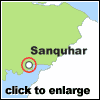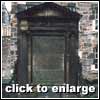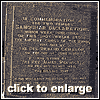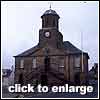By Brian Orr Have a question? Click Here to go to Brian's own
Discussion Board!
 Sanquhar is a small town in Dumftries and Galloway, in the south west of Scotland. It is of ancient origin, the name being Celtic and meaning Old Fort. It lies in north Nithsdale and is approximately midway between Dumfries and Kilmarnock. Small though it may be on the map, Sanquhar was the scene of no less than six "Declaration at Sanquhar". These were on June 22, 1680, (the Cameron Declaration); May 28, 1685 (the Renwick Declaration ) and four after the Revolution by parties who were not satisfied by the existing state of things. The four later Declarations were made on August 10, 1692, November 6, 1695, May 21, 1703 and the last in 1707.
Sanquhar is a small town in Dumftries and Galloway, in the south west of Scotland. It is of ancient origin, the name being Celtic and meaning Old Fort. It lies in north Nithsdale and is approximately midway between Dumfries and Kilmarnock. Small though it may be on the map, Sanquhar was the scene of no less than six "Declaration at Sanquhar". These were on June 22, 1680, (the Cameron Declaration); May 28, 1685 (the Renwick Declaration ) and four after the Revolution by parties who were not satisfied by the existing state of things. The four later Declarations were made on August 10, 1692, November 6, 1695, May 21, 1703 and the last in 1707.
There was, however, a precursor to the Cameron Declaration known as the Queensferry Paper which was the work of Donald Cargill in collaboration with Richard Cameron. Born at Rattray in Perthshire in 1619, Donald Cargill was at St. Andrews university at the same time as a later oppressor the Earl of Rothes. But he was of mature years before he was ordained as minister of the Barony Church in Glasgow in 1655. He was cast out of his ministry in 1662 and banned from the south side of the River Tay so he turned to private meetings and conventicles to pursue his ministry. Cargill was left for dead at Bothwell Brig but recovered to collaborate with The Queensferry Paper.
 The Queensferry Paper was a solemn declaration of faith and disavowed the sinful rulers. It is the strongest of the Covenanter manifestoes but was never published by the Covenanters themselves. Its disclosure came about because Cargill was taken prisoner with his companion Henry Hall at an Inn at Queensferry on June 3, 1680. Cargill managed to escape but Henry Hall was injured and later died. It was when Cargill's clothes were searched that the compromising paper was found.
The Queensferry Paper was a solemn declaration of faith and disavowed the sinful rulers. It is the strongest of the Covenanter manifestoes but was never published by the Covenanters themselves. Its disclosure came about because Cargill was taken prisoner with his companion Henry Hall at an Inn at Queensferry on June 3, 1680. Cargill managed to escape but Henry Hall was injured and later died. It was when Cargill's clothes were searched that the compromising paper was found.
Undaunted by the disclosure of the Queensferry Paper, Cargill continued his work and memorably preached at a gathering at Torwood, near Stirling. When he had completed his sermon from Ezekiel "Thus saith the Lord God, Remove the diadem and take off the crown" he calmly and formally excommunicated Charles Stuart, King of England; James Duke of York; James Duke of Monmouth; John Duke of Lauderdale; John Duke of Rothes; the Kings Advocate Sir George MacKenzie; and Thomas Dalzell of the Binns.
Sadly, it was not long before he was seized at Covington Mill where he had been resting for the night and he and companions Walter Smith and James Boig were hustled away to prison in Edinburgh. On July 27, 1681 he was executed at the Mercat Cross and his head hung on the Netherbow Gate in Edinburgh with his hands poised as if in prayer beneath - the manner reserved for Covenanting ministers.
 On June 22, 1680, that the townspeople of Sanquhar were astonished to see some twenty horsemen ride up the main street with swords drawn and pistols at the ready. The group halted at the market cross and two dismounted - these were Richard Cameron and his brother Michael. After a psalm was sung a prayer was offered to the assembled throng, and Michael Cameron read aloud the Sanquhar Declaration. When he was done, the Declaration was nailed to the town cross and the horsemen returned from whence they came. Thus was planted the seed for a free Parliament and an unshackled church.
On June 22, 1680, that the townspeople of Sanquhar were astonished to see some twenty horsemen ride up the main street with swords drawn and pistols at the ready. The group halted at the market cross and two dismounted - these were Richard Cameron and his brother Michael. After a psalm was sung a prayer was offered to the assembled throng, and Michael Cameron read aloud the Sanquhar Declaration. When he was done, the Declaration was nailed to the town cross and the horsemen returned from whence they came. Thus was planted the seed for a free Parliament and an unshackled church.
The Sanquhar Declaration which is forever associated with the "Cameronians" was published exactly one year after the Battle of Bothwell, and a month prior to Cameron's own death at Airds Moss. This Declaration deserves notice, both on account of the prominence given to it at the time by the persecuted Presbyterians, and also because it was used as an excuse for criminal prosecution of those who acknowledged it. "Do you own the Sanquhar Declaration?" was a question to which an answer of "yes" meant they would be subjected to whatever punishment the whim of the judges or the soldiers in the field might see proper to inflict - usually death, often on the spot.
 It was regarded as a manifesto of a highly treasonable nature because it disowned King Charles as the lawful king of the realms, and coming so soon after the battle of Bothwell Brigg, it was the means of stimulating the persecution of the Covenanters. Moreover, the attention of the government became focused on that part of the country where this Declaration was made public. As a result, the army was the instrument of a merciless persecution and excution of the Covenanters in the south west of Scotland. So many people died for the principles of the Declaration that it is worth reproducing it in full below.
It was regarded as a manifesto of a highly treasonable nature because it disowned King Charles as the lawful king of the realms, and coming so soon after the battle of Bothwell Brigg, it was the means of stimulating the persecution of the Covenanters. Moreover, the attention of the government became focused on that part of the country where this Declaration was made public. As a result, the army was the instrument of a merciless persecution and excution of the Covenanters in the south west of Scotland. So many people died for the principles of the Declaration that it is worth reproducing it in full below.
"The Declaration and Testimony of the True Presbyterian, Anti-prelatic, Anti-erastian, persecuted party in Scotland." Published at Sanquhar, June 22, 1680.
Quoted from " The Traditions of the Covenanters" by the Rev Robert Simpson ( 1867).
"It is not amongst the smallest of the Lord's mercies to this poor land, that there have been always some who have given their testimony against every cause of defection that many are guilty of; which is a token for good, that he doth not, as yet, intend to cast us off altogether, but that he will leave a remnant in whom lie will be glorious, if they. through his grace, keep themselves clean still, and walk in his way and method as it has been walked in, and owned by him in our predecessors of truly worthy memory; in their carrying on of our noble work of reformation, in the several steps thereof, from Popery, Prelacy, and likewise Erastian supremacy-so much usurped by him who, it is true, so far as we know, is descended from the race of our kings; yet he hath so far debased from what he ought to have been, by his perjury and usurpation in Church matters, and tyranny in matters civil, as is known by the whole land, that we have just reason to account it one of the Lord's great controversies against us, that we have not disowned him, and the men of his practices, whether inferior magistrates or any other, as enemies to our Lord and his crown, and the true Protestant and Presbyterian interest in this land-our Lord's espoused bride and Church. Therefore, although we be for government and governors, such as the Word of God and our covenant allows; yet we, for ourselves, and all that will adhere to us as the representative of the true Presbyterian Kirk and covenanted nation of Scotland, considering the great hazard of lying under such a sin any longer, do, by these presents,disown Charles Stuart, that has been reigning, or rather tyrannizing, as we may say, on the throne of Britain these years bygone, as having any right, title to, or interest in, the said crown of Scotland for government, as forfeited, several years since, by his perjury and breach of covenant both to God and his Kirk, and usurpation of his crown and royal prerogative therein, and many other breaches in matters eccelesiastic and by his tyranny and breach of the very reges regnandi in matters civil. For which reason we declare, that several years since he should have been denuded of being king, ruler, or magistrate, or of having any power to act or to be obeyed as such. As also we' being under the standard of our Lord Jesus Christ, Captain of Salvation, do declare a war with such a tyrant and usurper, and all the men of his practices, as enemies to our Lord Jesus Christ, and his cause and covenants; and against all such as have strengthened him, sided with, or anywise acknowledged him in his tyranny, civil or ecclesiastic; yea, against all such as shall strengthen, side with, or anywise acknowledge any other in like usurpation and tyranny-far more against such as would betray or deliver up our free reformed mother Kirk unto the bondage of Antichrist, the Pope of Rome. And, by this, we homologate that testimony given at Rutherglen, the 29th of May 1679, and all the faithful testimonies of those who have gone before, as also of those who have suffered of late. and we do disclaim that Declaration published at Hamilton, June 1679, chiefly because it takes in the king's interest, which we are several years since loosed from, because of the aforesaid reasons,and others which may, after this, if the Lord will, be published. As also, we disown and by this resent the reception of the Duke of York, that professed Papist, as repugnant to our principles and vows to the Most High God, and as that which is the great, though not alone,just reproach of our Kirk and nation. We also, by this,protest against his succeeding to the crown, and whatever has been done, or any are essaying to do in this land, given to the Lord, in prejudice to our work of reformation. And to conclude, we hope. after this, none will blame us for, or offend at, our rewarding those that are against as they have done to us, as the Lord gives opportunity. This is not to exclude any that have declined, if they be willing to give satisfaction according to the degree of their offence. "
 The "Cameronians" as they became known, refused to take an oath of allegiance to King William III after the religous settlements of 1689 - 1690. They felt that they could not join the newly formed Church of Scotland, even though it was Presbyterian, because it ignored the Covenants and accepted some State interference in religous matters.
The "Cameronians" as they became known, refused to take an oath of allegiance to King William III after the religous settlements of 1689 - 1690. They felt that they could not join the newly formed Church of Scotland, even though it was Presbyterian, because it ignored the Covenants and accepted some State interference in religous matters.
The Cameronians accepted the Crown's right to dissolve Assemblies and they even accepted the system of patronage so they were not totally against the King. For sixteen years, the dissenting Covenanters maintained their own Societies for worship and religious correspondence. By I706 there existed in Scotland twenty such Societies, with a membership of roughly seven thousand. In 1743 these formed their own Reformed Presbytery which spread to Ulster and the USA.
The Church membership increased quite rapidly and was a clear reflection of a desire for a firm Presbyterian church. In 1810 the Presbytery was divided regionally into a Northern, Eastern, and Southern Presbytery. A year later, these three Presbyteries convened as the first Synod of the Reformed Presbyterian Church of Scotland. In 1810 the Irish and the North American Reformed Presbyterian Churches - offshoots of the Scottish - were also strong enough to set up their own first Synods.
 There was further division among the Cameronians in 1863 over the question of parliamentary franchise when a majority took the view that they should do away with the rule about political dissent - which meant abandoning a principle of the Covenant to share responsibility for national sins. The minority set up their own Synod and reiterated that they would not accept political systems which, in the Synods view, ignored the primary rights of Christ Jesus as King of the world's nations. In 1876 most were reconciled with and joined the Free Church of Scotland.
There was further division among the Cameronians in 1863 over the question of parliamentary franchise when a majority took the view that they should do away with the rule about political dissent - which meant abandoning a principle of the Covenant to share responsibility for national sins. The minority set up their own Synod and reiterated that they would not accept political systems which, in the Synods view, ignored the primary rights of Christ Jesus as King of the world's nations. In 1876 most were reconciled with and joined the Free Church of Scotland.
The final word on the trials of the Covenanters perhaps lies in the stark detail of the inscription on the Martyrs Monument in Old Greyfriars Kirkyard which says that between May 1661 and February 1688 that
"... were one way or other murdered and destroyed for the same cause about eighteen thousand, of whom were executed at Edinburgh about a hundred of noblemen and gentlemen, ministers and others - noble Martyrs for Jesus Christ. The most of them lie here..."
Meet the Author, Brian Orr, Researcher with The Guild of One Name Studies
Back to The Covenanters, Main Page
Part One: The Covenanters: Who Were They?
Part Two : The Kirk and its Impact on the People
Part Three : Tales of the Covenanters
Part Four : What's in a Name?
Part Five : The Sanquhar Declaration
Part Six : Covenanter Ships: The Eaglewing, The Crown and Henry & Francis
Part Seven : Female Covenanters: Execution by Drowning
Part Eight : Covenanter Prisons: Bass Rock and Dunnattor Castle
Part Nine : Greyfriars Kirk and the National Covenant
Part Ten : Battle of Rullion Green
Part Eleven : Rev. James Renwick, Martyr
Part Twelve : Presbyterians in Ireland
Part Thirteen: The Final Word on the Solway Martyrs
Part Fourteen: The Margaret Wilson Statue
Part Fifteen: After the National Covenant






